University Medication Administration Assignment - Trimester 2, 2019
VerifiedAdded on 2022/12/21
|12
|3418
|54
Homework Assignment
AI Summary
This assignment solution addresses key aspects of medication administration, including the regulatory framework in Australia (TGA), principles of pharmacokinetics and pharmacodynamics, and the roles of healthcare professionals (nurses, doctors, pharmacists) in the medication cycle. It explores the phases of drug development, the hepatic first-pass effect, and provides specific information on medications like Glyceryl Trinitrate, including patient education. The solution also delves into the medication management cycle, identifies factors contributing to medication errors (communication, workload, training), and presents preventive measures. Furthermore, it discusses person-centered and system approaches to error management, along with the Swiss cheese model, highlighting latent conditions and active failures. The assignment emphasizes the importance of safe medication practices and strategies to minimize errors in healthcare settings.
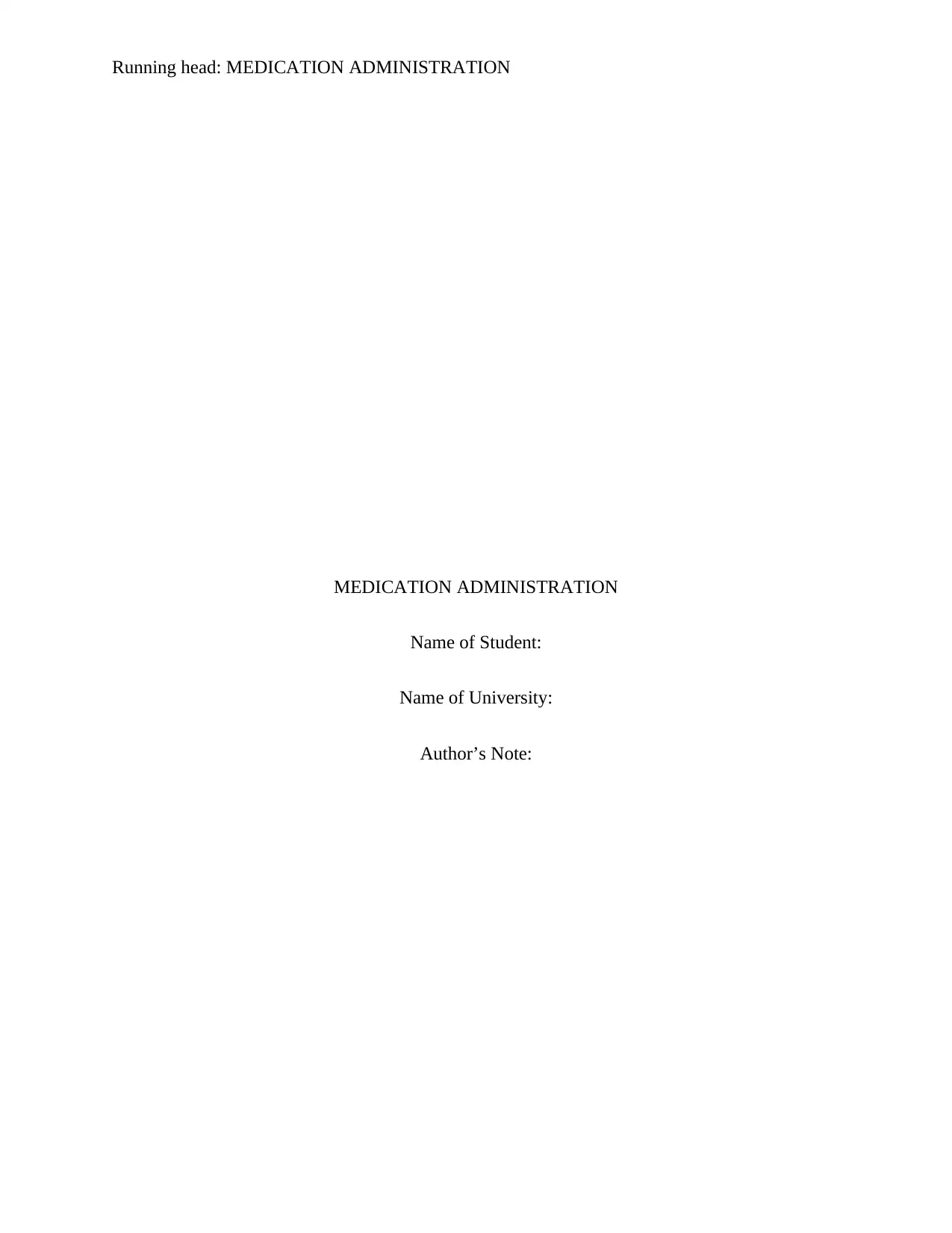
Running head: MEDICATION ADMINISTRATION
MEDICATION ADMINISTRATION
Name of Student:
Name of University:
Author’s Note:
MEDICATION ADMINISTRATION
Name of Student:
Name of University:
Author’s Note:
Paraphrase This Document
Need a fresh take? Get an instant paraphrase of this document with our AI Paraphraser
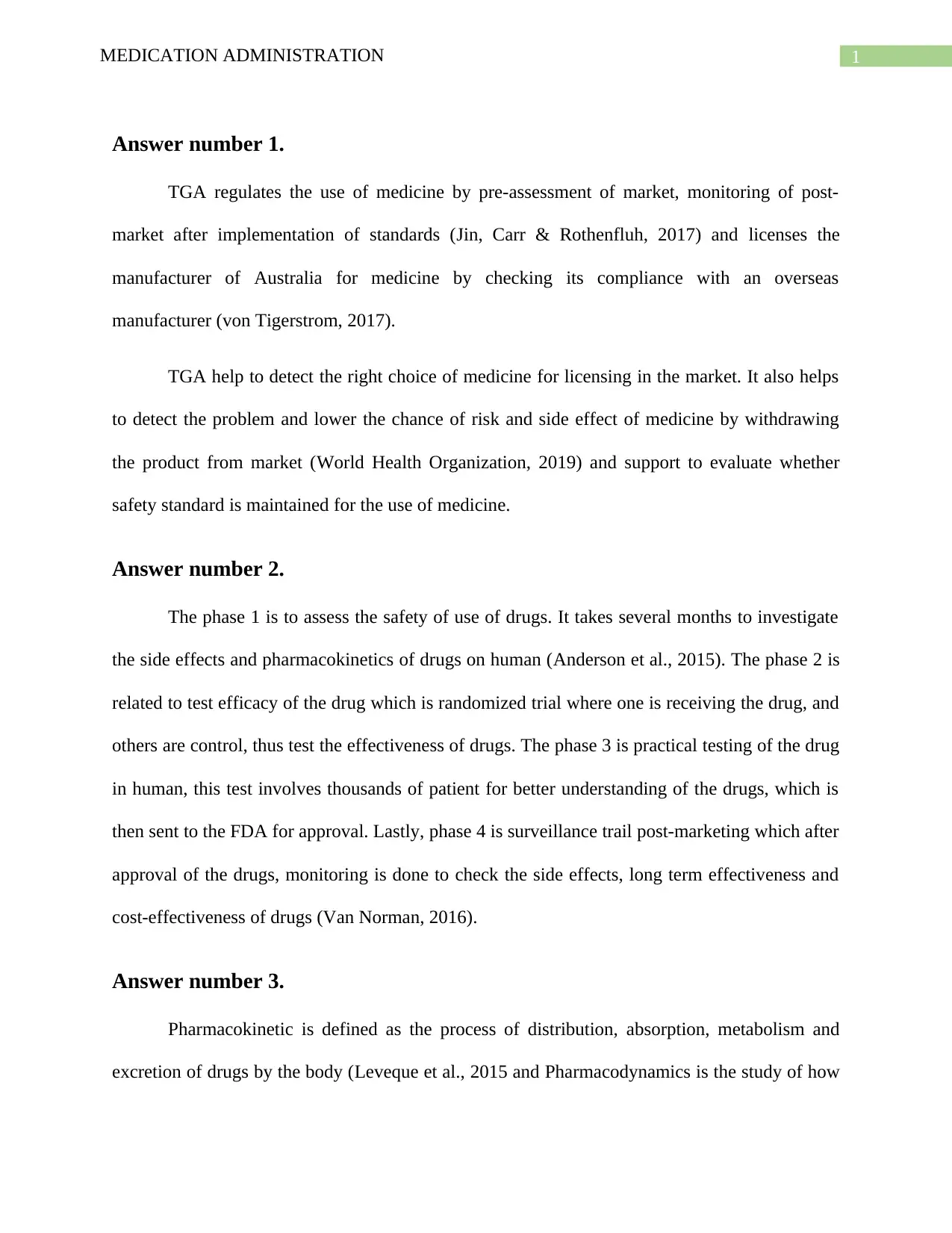
1MEDICATION ADMINISTRATION
Answer number 1.
TGA regulates the use of medicine by pre-assessment of market, monitoring of post-
market after implementation of standards (Jin, Carr & Rothenfluh, 2017) and licenses the
manufacturer of Australia for medicine by checking its compliance with an overseas
manufacturer (von Tigerstrom, 2017).
TGA help to detect the right choice of medicine for licensing in the market. It also helps
to detect the problem and lower the chance of risk and side effect of medicine by withdrawing
the product from market (World Health Organization, 2019) and support to evaluate whether
safety standard is maintained for the use of medicine.
Answer number 2.
The phase 1 is to assess the safety of use of drugs. It takes several months to investigate
the side effects and pharmacokinetics of drugs on human (Anderson et al., 2015). The phase 2 is
related to test efficacy of the drug which is randomized trial where one is receiving the drug, and
others are control, thus test the effectiveness of drugs. The phase 3 is practical testing of the drug
in human, this test involves thousands of patient for better understanding of the drugs, which is
then sent to the FDA for approval. Lastly, phase 4 is surveillance trail post-marketing which after
approval of the drugs, monitoring is done to check the side effects, long term effectiveness and
cost-effectiveness of drugs (Van Norman, 2016).
Answer number 3.
Pharmacokinetic is defined as the process of distribution, absorption, metabolism and
excretion of drugs by the body (Leveque et al., 2015 and Pharmacodynamics is the study of how
Answer number 1.
TGA regulates the use of medicine by pre-assessment of market, monitoring of post-
market after implementation of standards (Jin, Carr & Rothenfluh, 2017) and licenses the
manufacturer of Australia for medicine by checking its compliance with an overseas
manufacturer (von Tigerstrom, 2017).
TGA help to detect the right choice of medicine for licensing in the market. It also helps
to detect the problem and lower the chance of risk and side effect of medicine by withdrawing
the product from market (World Health Organization, 2019) and support to evaluate whether
safety standard is maintained for the use of medicine.
Answer number 2.
The phase 1 is to assess the safety of use of drugs. It takes several months to investigate
the side effects and pharmacokinetics of drugs on human (Anderson et al., 2015). The phase 2 is
related to test efficacy of the drug which is randomized trial where one is receiving the drug, and
others are control, thus test the effectiveness of drugs. The phase 3 is practical testing of the drug
in human, this test involves thousands of patient for better understanding of the drugs, which is
then sent to the FDA for approval. Lastly, phase 4 is surveillance trail post-marketing which after
approval of the drugs, monitoring is done to check the side effects, long term effectiveness and
cost-effectiveness of drugs (Van Norman, 2016).
Answer number 3.
Pharmacokinetic is defined as the process of distribution, absorption, metabolism and
excretion of drugs by the body (Leveque et al., 2015 and Pharmacodynamics is the study of how
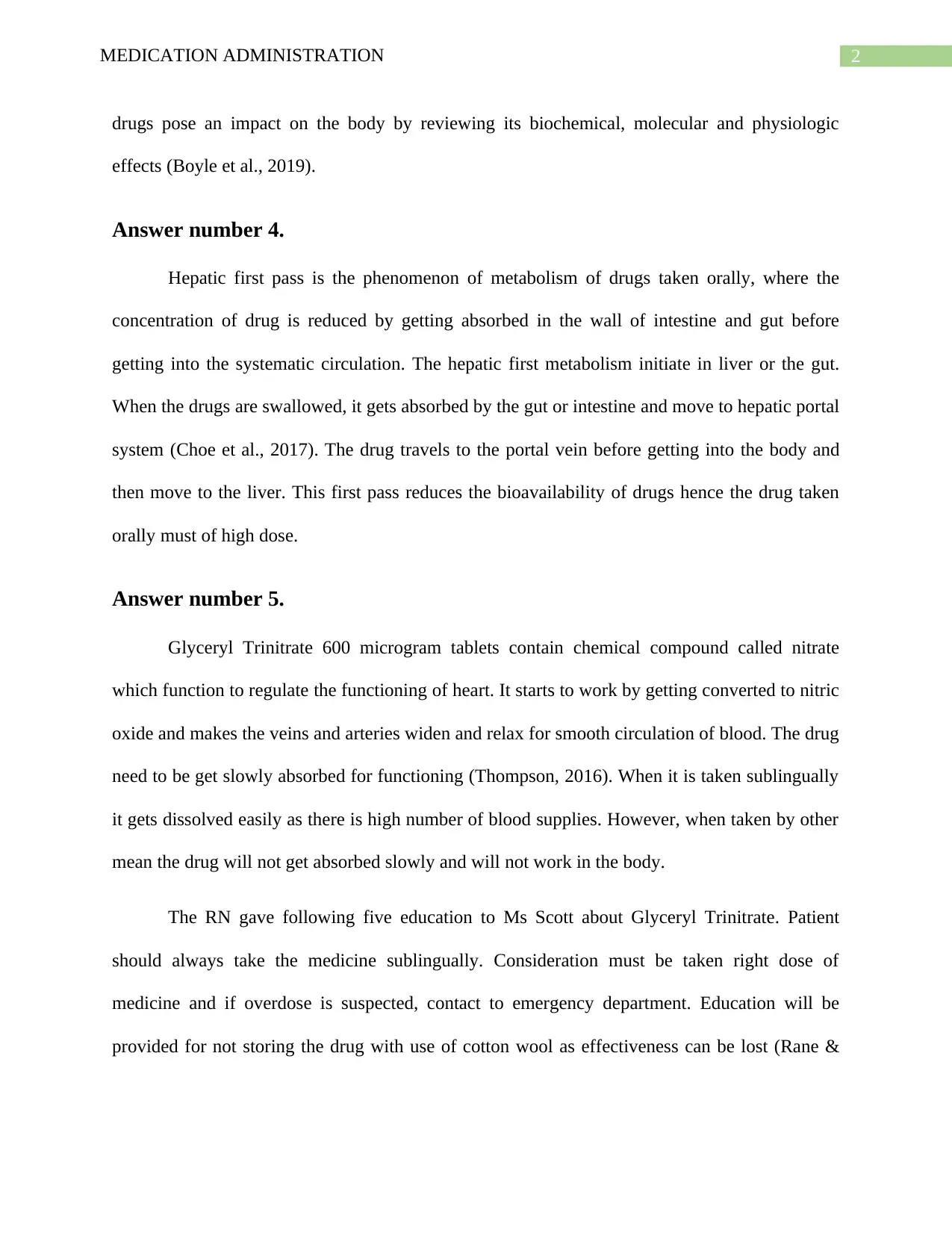
2MEDICATION ADMINISTRATION
drugs pose an impact on the body by reviewing its biochemical, molecular and physiologic
effects (Boyle et al., 2019).
Answer number 4.
Hepatic first pass is the phenomenon of metabolism of drugs taken orally, where the
concentration of drug is reduced by getting absorbed in the wall of intestine and gut before
getting into the systematic circulation. The hepatic first metabolism initiate in liver or the gut.
When the drugs are swallowed, it gets absorbed by the gut or intestine and move to hepatic portal
system (Choe et al., 2017). The drug travels to the portal vein before getting into the body and
then move to the liver. This first pass reduces the bioavailability of drugs hence the drug taken
orally must of high dose.
Answer number 5.
Glyceryl Trinitrate 600 microgram tablets contain chemical compound called nitrate
which function to regulate the functioning of heart. It starts to work by getting converted to nitric
oxide and makes the veins and arteries widen and relax for smooth circulation of blood. The drug
need to be get slowly absorbed for functioning (Thompson, 2016). When it is taken sublingually
it gets dissolved easily as there is high number of blood supplies. However, when taken by other
mean the drug will not get absorbed slowly and will not work in the body.
The RN gave following five education to Ms Scott about Glyceryl Trinitrate. Patient
should always take the medicine sublingually. Consideration must be taken right dose of
medicine and if overdose is suspected, contact to emergency department. Education will be
provided for not storing the drug with use of cotton wool as effectiveness can be lost (Rane &
drugs pose an impact on the body by reviewing its biochemical, molecular and physiologic
effects (Boyle et al., 2019).
Answer number 4.
Hepatic first pass is the phenomenon of metabolism of drugs taken orally, where the
concentration of drug is reduced by getting absorbed in the wall of intestine and gut before
getting into the systematic circulation. The hepatic first metabolism initiate in liver or the gut.
When the drugs are swallowed, it gets absorbed by the gut or intestine and move to hepatic portal
system (Choe et al., 2017). The drug travels to the portal vein before getting into the body and
then move to the liver. This first pass reduces the bioavailability of drugs hence the drug taken
orally must of high dose.
Answer number 5.
Glyceryl Trinitrate 600 microgram tablets contain chemical compound called nitrate
which function to regulate the functioning of heart. It starts to work by getting converted to nitric
oxide and makes the veins and arteries widen and relax for smooth circulation of blood. The drug
need to be get slowly absorbed for functioning (Thompson, 2016). When it is taken sublingually
it gets dissolved easily as there is high number of blood supplies. However, when taken by other
mean the drug will not get absorbed slowly and will not work in the body.
The RN gave following five education to Ms Scott about Glyceryl Trinitrate. Patient
should always take the medicine sublingually. Consideration must be taken right dose of
medicine and if overdose is suspected, contact to emergency department. Education will be
provided for not storing the drug with use of cotton wool as effectiveness can be lost (Rane &
⊘ This is a preview!⊘
Do you want full access?
Subscribe today to unlock all pages.

Trusted by 1+ million students worldwide
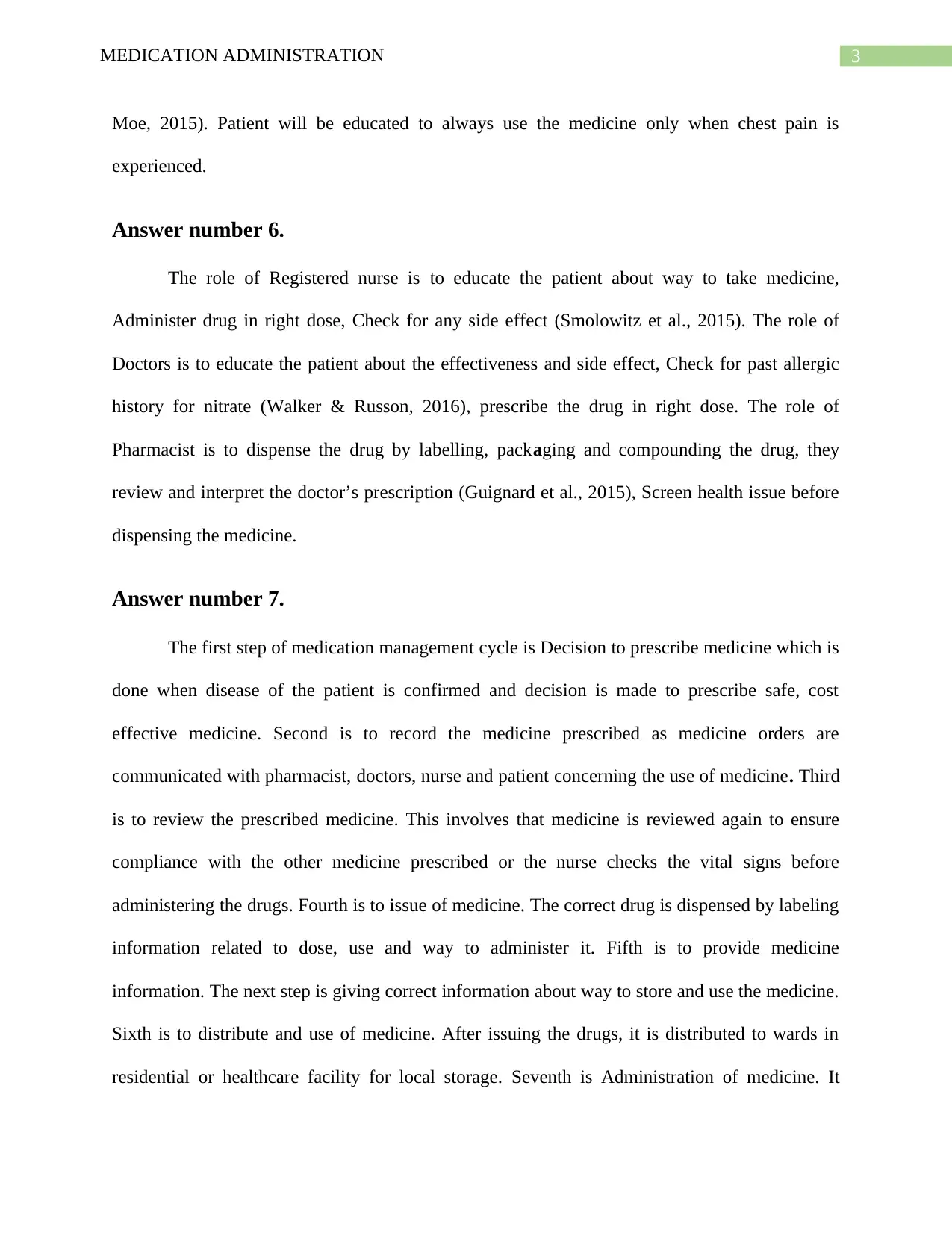
3MEDICATION ADMINISTRATION
Moe, 2015). Patient will be educated to always use the medicine only when chest pain is
experienced.
Answer number 6.
The role of Registered nurse is to educate the patient about way to take medicine,
Administer drug in right dose, Check for any side effect (Smolowitz et al., 2015). The role of
Doctors is to educate the patient about the effectiveness and side effect, Check for past allergic
history for nitrate (Walker & Russon, 2016), prescribe the drug in right dose. The role of
Pharmacist is to dispense the drug by labelling, packaging and compounding the drug, they
review and interpret the doctor’s prescription (Guignard et al., 2015), Screen health issue before
dispensing the medicine.
Answer number 7.
The first step of medication management cycle is Decision to prescribe medicine which is
done when disease of the patient is confirmed and decision is made to prescribe safe, cost
effective medicine. Second is to record the medicine prescribed as medicine orders are
communicated with pharmacist, doctors, nurse and patient concerning the use of medicine. Third
is to review the prescribed medicine. This involves that medicine is reviewed again to ensure
compliance with the other medicine prescribed or the nurse checks the vital signs before
administering the drugs. Fourth is to issue of medicine. The correct drug is dispensed by labeling
information related to dose, use and way to administer it. Fifth is to provide medicine
information. The next step is giving correct information about way to store and use the medicine.
Sixth is to distribute and use of medicine. After issuing the drugs, it is distributed to wards in
residential or healthcare facility for local storage. Seventh is Administration of medicine. It
Moe, 2015). Patient will be educated to always use the medicine only when chest pain is
experienced.
Answer number 6.
The role of Registered nurse is to educate the patient about way to take medicine,
Administer drug in right dose, Check for any side effect (Smolowitz et al., 2015). The role of
Doctors is to educate the patient about the effectiveness and side effect, Check for past allergic
history for nitrate (Walker & Russon, 2016), prescribe the drug in right dose. The role of
Pharmacist is to dispense the drug by labelling, packaging and compounding the drug, they
review and interpret the doctor’s prescription (Guignard et al., 2015), Screen health issue before
dispensing the medicine.
Answer number 7.
The first step of medication management cycle is Decision to prescribe medicine which is
done when disease of the patient is confirmed and decision is made to prescribe safe, cost
effective medicine. Second is to record the medicine prescribed as medicine orders are
communicated with pharmacist, doctors, nurse and patient concerning the use of medicine. Third
is to review the prescribed medicine. This involves that medicine is reviewed again to ensure
compliance with the other medicine prescribed or the nurse checks the vital signs before
administering the drugs. Fourth is to issue of medicine. The correct drug is dispensed by labeling
information related to dose, use and way to administer it. Fifth is to provide medicine
information. The next step is giving correct information about way to store and use the medicine.
Sixth is to distribute and use of medicine. After issuing the drugs, it is distributed to wards in
residential or healthcare facility for local storage. Seventh is Administration of medicine. It
Paraphrase This Document
Need a fresh take? Get an instant paraphrase of this document with our AI Paraphraser
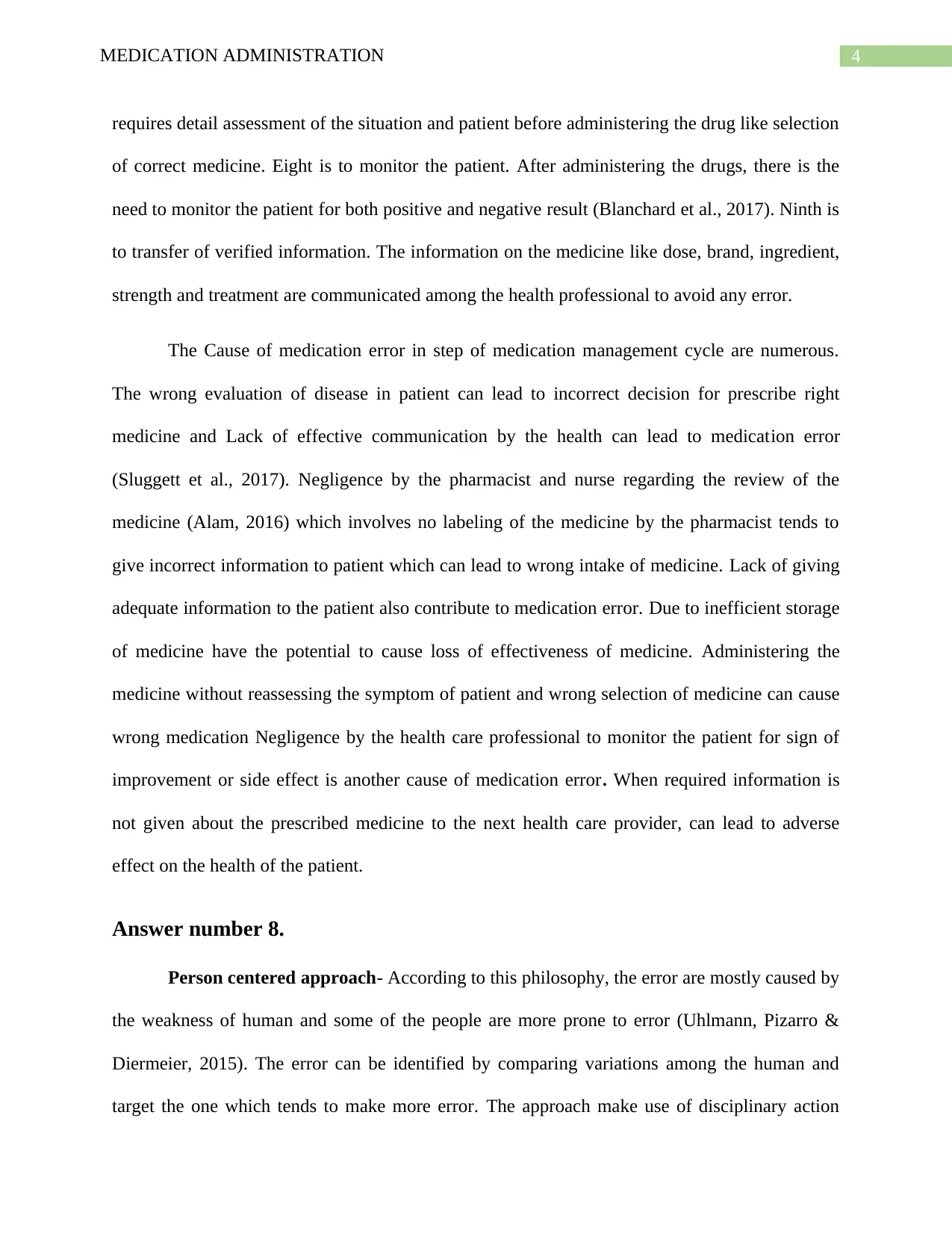
4MEDICATION ADMINISTRATION
requires detail assessment of the situation and patient before administering the drug like selection
of correct medicine. Eight is to monitor the patient. After administering the drugs, there is the
need to monitor the patient for both positive and negative result (Blanchard et al., 2017). Ninth is
to transfer of verified information. The information on the medicine like dose, brand, ingredient,
strength and treatment are communicated among the health professional to avoid any error.
The Cause of medication error in step of medication management cycle are numerous.
The wrong evaluation of disease in patient can lead to incorrect decision for prescribe right
medicine and Lack of effective communication by the health can lead to medication error
(Sluggett et al., 2017). Negligence by the pharmacist and nurse regarding the review of the
medicine (Alam, 2016) which involves no labeling of the medicine by the pharmacist tends to
give incorrect information to patient which can lead to wrong intake of medicine. Lack of giving
adequate information to the patient also contribute to medication error. Due to inefficient storage
of medicine have the potential to cause loss of effectiveness of medicine. Administering the
medicine without reassessing the symptom of patient and wrong selection of medicine can cause
wrong medication Negligence by the health care professional to monitor the patient for sign of
improvement or side effect is another cause of medication error. When required information is
not given about the prescribed medicine to the next health care provider, can lead to adverse
effect on the health of the patient.
Answer number 8.
Person centered approach- According to this philosophy, the error are mostly caused by
the weakness of human and some of the people are more prone to error (Uhlmann, Pizarro &
Diermeier, 2015). The error can be identified by comparing variations among the human and
target the one which tends to make more error. The approach make use of disciplinary action
requires detail assessment of the situation and patient before administering the drug like selection
of correct medicine. Eight is to monitor the patient. After administering the drugs, there is the
need to monitor the patient for both positive and negative result (Blanchard et al., 2017). Ninth is
to transfer of verified information. The information on the medicine like dose, brand, ingredient,
strength and treatment are communicated among the health professional to avoid any error.
The Cause of medication error in step of medication management cycle are numerous.
The wrong evaluation of disease in patient can lead to incorrect decision for prescribe right
medicine and Lack of effective communication by the health can lead to medication error
(Sluggett et al., 2017). Negligence by the pharmacist and nurse regarding the review of the
medicine (Alam, 2016) which involves no labeling of the medicine by the pharmacist tends to
give incorrect information to patient which can lead to wrong intake of medicine. Lack of giving
adequate information to the patient also contribute to medication error. Due to inefficient storage
of medicine have the potential to cause loss of effectiveness of medicine. Administering the
medicine without reassessing the symptom of patient and wrong selection of medicine can cause
wrong medication Negligence by the health care professional to monitor the patient for sign of
improvement or side effect is another cause of medication error. When required information is
not given about the prescribed medicine to the next health care provider, can lead to adverse
effect on the health of the patient.
Answer number 8.
Person centered approach- According to this philosophy, the error are mostly caused by
the weakness of human and some of the people are more prone to error (Uhlmann, Pizarro &
Diermeier, 2015). The error can be identified by comparing variations among the human and
target the one which tends to make more error. The approach make use of disciplinary action
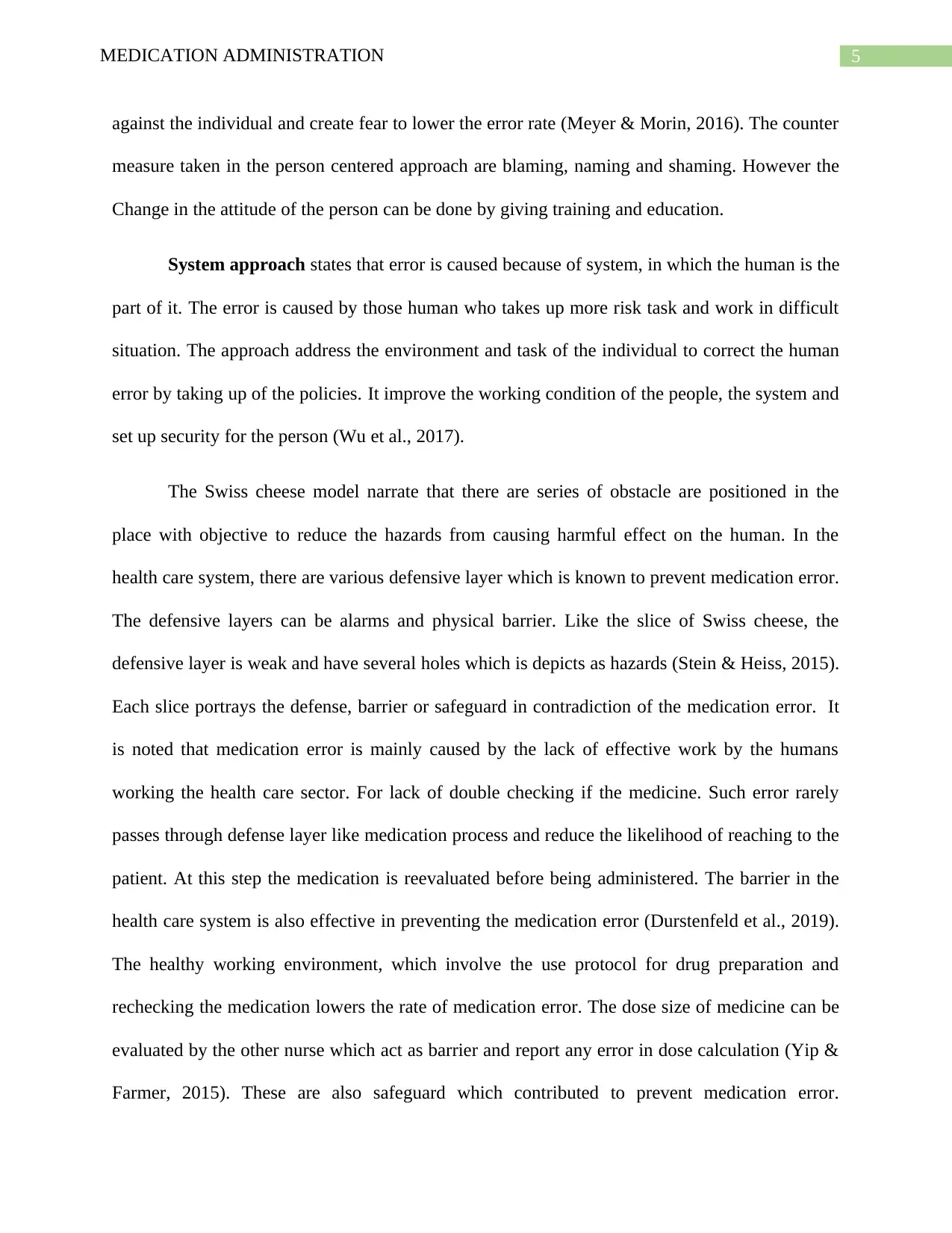
5MEDICATION ADMINISTRATION
against the individual and create fear to lower the error rate (Meyer & Morin, 2016). The counter
measure taken in the person centered approach are blaming, naming and shaming. However the
Change in the attitude of the person can be done by giving training and education.
System approach states that error is caused because of system, in which the human is the
part of it. The error is caused by those human who takes up more risk task and work in difficult
situation. The approach address the environment and task of the individual to correct the human
error by taking up of the policies. It improve the working condition of the people, the system and
set up security for the person (Wu et al., 2017).
The Swiss cheese model narrate that there are series of obstacle are positioned in the
place with objective to reduce the hazards from causing harmful effect on the human. In the
health care system, there are various defensive layer which is known to prevent medication error.
The defensive layers can be alarms and physical barrier. Like the slice of Swiss cheese, the
defensive layer is weak and have several holes which is depicts as hazards (Stein & Heiss, 2015).
Each slice portrays the defense, barrier or safeguard in contradiction of the medication error. It
is noted that medication error is mainly caused by the lack of effective work by the humans
working the health care sector. For lack of double checking if the medicine. Such error rarely
passes through defense layer like medication process and reduce the likelihood of reaching to the
patient. At this step the medication is reevaluated before being administered. The barrier in the
health care system is also effective in preventing the medication error (Durstenfeld et al., 2019).
The healthy working environment, which involve the use protocol for drug preparation and
rechecking the medication lowers the rate of medication error. The dose size of medicine can be
evaluated by the other nurse which act as barrier and report any error in dose calculation (Yip &
Farmer, 2015). These are also safeguard which contributed to prevent medication error.
against the individual and create fear to lower the error rate (Meyer & Morin, 2016). The counter
measure taken in the person centered approach are blaming, naming and shaming. However the
Change in the attitude of the person can be done by giving training and education.
System approach states that error is caused because of system, in which the human is the
part of it. The error is caused by those human who takes up more risk task and work in difficult
situation. The approach address the environment and task of the individual to correct the human
error by taking up of the policies. It improve the working condition of the people, the system and
set up security for the person (Wu et al., 2017).
The Swiss cheese model narrate that there are series of obstacle are positioned in the
place with objective to reduce the hazards from causing harmful effect on the human. In the
health care system, there are various defensive layer which is known to prevent medication error.
The defensive layers can be alarms and physical barrier. Like the slice of Swiss cheese, the
defensive layer is weak and have several holes which is depicts as hazards (Stein & Heiss, 2015).
Each slice portrays the defense, barrier or safeguard in contradiction of the medication error. It
is noted that medication error is mainly caused by the lack of effective work by the humans
working the health care sector. For lack of double checking if the medicine. Such error rarely
passes through defense layer like medication process and reduce the likelihood of reaching to the
patient. At this step the medication is reevaluated before being administered. The barrier in the
health care system is also effective in preventing the medication error (Durstenfeld et al., 2019).
The healthy working environment, which involve the use protocol for drug preparation and
rechecking the medication lowers the rate of medication error. The dose size of medicine can be
evaluated by the other nurse which act as barrier and report any error in dose calculation (Yip &
Farmer, 2015). These are also safeguard which contributed to prevent medication error.
⊘ This is a preview!⊘
Do you want full access?
Subscribe today to unlock all pages.

Trusted by 1+ million students worldwide
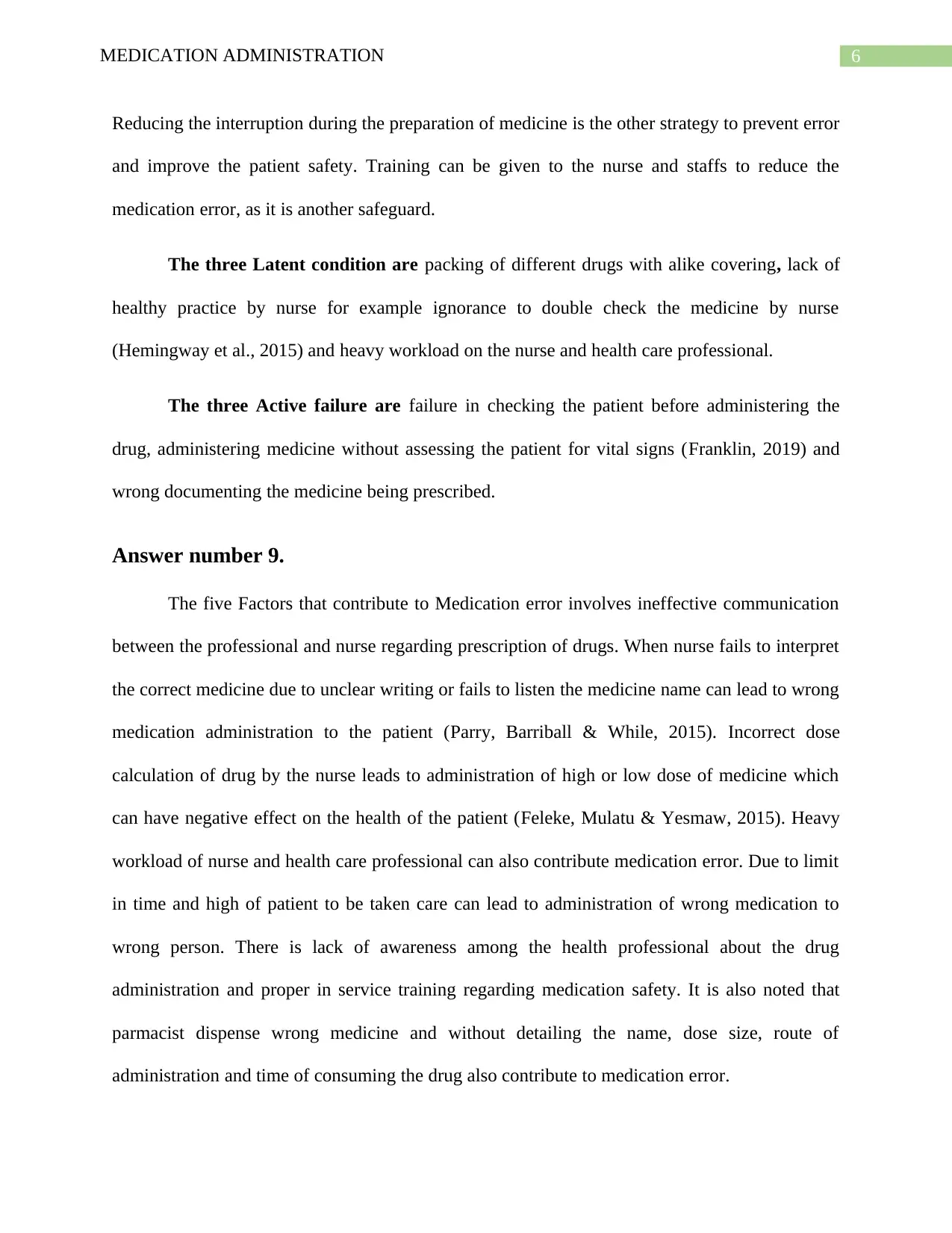
6MEDICATION ADMINISTRATION
Reducing the interruption during the preparation of medicine is the other strategy to prevent error
and improve the patient safety. Training can be given to the nurse and staffs to reduce the
medication error, as it is another safeguard.
The three Latent condition are packing of different drugs with alike covering, lack of
healthy practice by nurse for example ignorance to double check the medicine by nurse
(Hemingway et al., 2015) and heavy workload on the nurse and health care professional.
The three Active failure are failure in checking the patient before administering the
drug, administering medicine without assessing the patient for vital signs (Franklin, 2019) and
wrong documenting the medicine being prescribed.
Answer number 9.
The five Factors that contribute to Medication error involves ineffective communication
between the professional and nurse regarding prescription of drugs. When nurse fails to interpret
the correct medicine due to unclear writing or fails to listen the medicine name can lead to wrong
medication administration to the patient (Parry, Barriball & While, 2015). Incorrect dose
calculation of drug by the nurse leads to administration of high or low dose of medicine which
can have negative effect on the health of the patient (Feleke, Mulatu & Yesmaw, 2015). Heavy
workload of nurse and health care professional can also contribute medication error. Due to limit
in time and high of patient to be taken care can lead to administration of wrong medication to
wrong person. There is lack of awareness among the health professional about the drug
administration and proper in service training regarding medication safety. It is also noted that
parmacist dispense wrong medicine and without detailing the name, dose size, route of
administration and time of consuming the drug also contribute to medication error.
Reducing the interruption during the preparation of medicine is the other strategy to prevent error
and improve the patient safety. Training can be given to the nurse and staffs to reduce the
medication error, as it is another safeguard.
The three Latent condition are packing of different drugs with alike covering, lack of
healthy practice by nurse for example ignorance to double check the medicine by nurse
(Hemingway et al., 2015) and heavy workload on the nurse and health care professional.
The three Active failure are failure in checking the patient before administering the
drug, administering medicine without assessing the patient for vital signs (Franklin, 2019) and
wrong documenting the medicine being prescribed.
Answer number 9.
The five Factors that contribute to Medication error involves ineffective communication
between the professional and nurse regarding prescription of drugs. When nurse fails to interpret
the correct medicine due to unclear writing or fails to listen the medicine name can lead to wrong
medication administration to the patient (Parry, Barriball & While, 2015). Incorrect dose
calculation of drug by the nurse leads to administration of high or low dose of medicine which
can have negative effect on the health of the patient (Feleke, Mulatu & Yesmaw, 2015). Heavy
workload of nurse and health care professional can also contribute medication error. Due to limit
in time and high of patient to be taken care can lead to administration of wrong medication to
wrong person. There is lack of awareness among the health professional about the drug
administration and proper in service training regarding medication safety. It is also noted that
parmacist dispense wrong medicine and without detailing the name, dose size, route of
administration and time of consuming the drug also contribute to medication error.
Paraphrase This Document
Need a fresh take? Get an instant paraphrase of this document with our AI Paraphraser
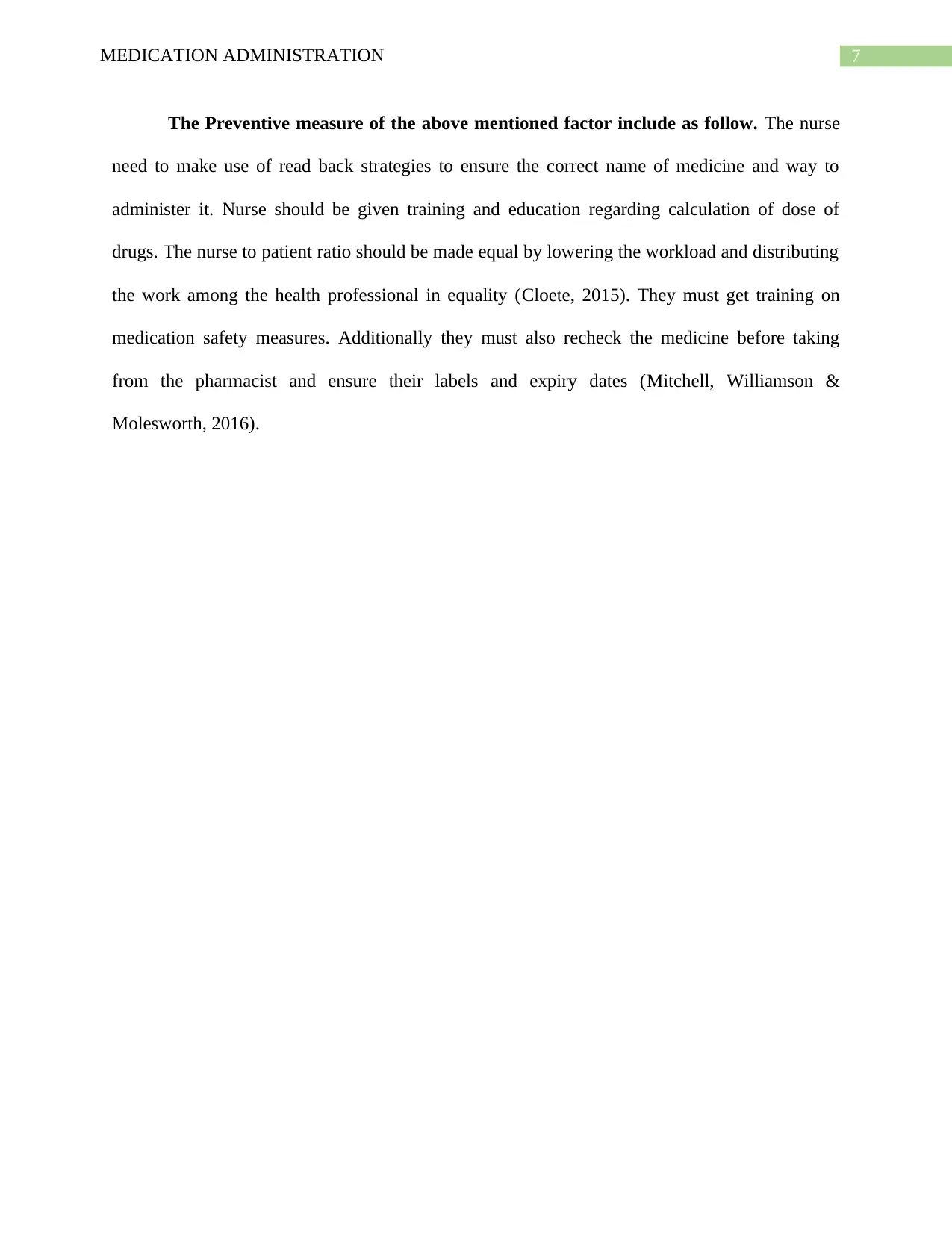
7MEDICATION ADMINISTRATION
The Preventive measure of the above mentioned factor include as follow. The nurse
need to make use of read back strategies to ensure the correct name of medicine and way to
administer it. Nurse should be given training and education regarding calculation of dose of
drugs. The nurse to patient ratio should be made equal by lowering the workload and distributing
the work among the health professional in equality (Cloete, 2015). They must get training on
medication safety measures. Additionally they must also recheck the medicine before taking
from the pharmacist and ensure their labels and expiry dates (Mitchell, Williamson &
Molesworth, 2016).
The Preventive measure of the above mentioned factor include as follow. The nurse
need to make use of read back strategies to ensure the correct name of medicine and way to
administer it. Nurse should be given training and education regarding calculation of dose of
drugs. The nurse to patient ratio should be made equal by lowering the workload and distributing
the work among the health professional in equality (Cloete, 2015). They must get training on
medication safety measures. Additionally they must also recheck the medicine before taking
from the pharmacist and ensure their labels and expiry dates (Mitchell, Williamson &
Molesworth, 2016).
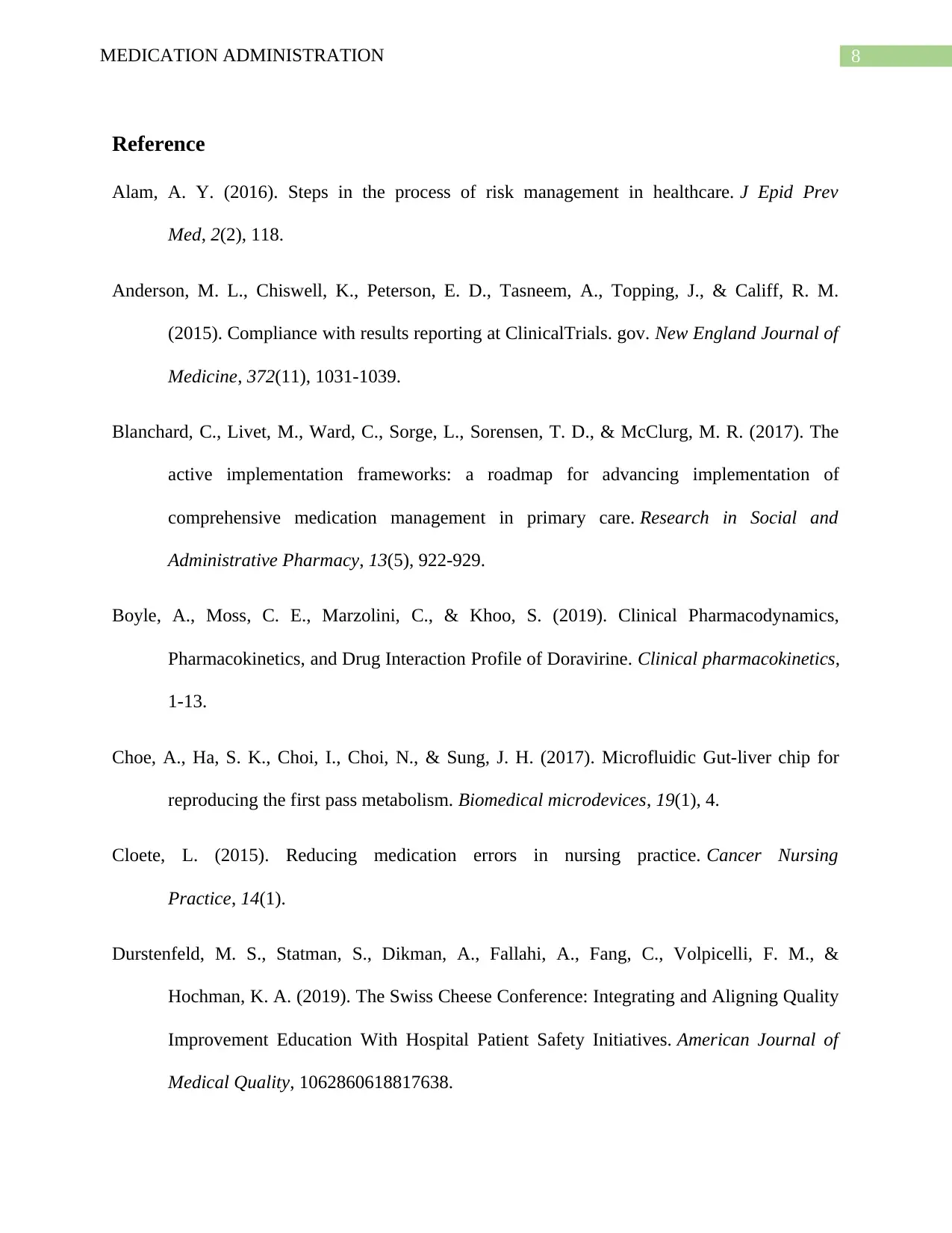
8MEDICATION ADMINISTRATION
Reference
Alam, A. Y. (2016). Steps in the process of risk management in healthcare. J Epid Prev
Med, 2(2), 118.
Anderson, M. L., Chiswell, K., Peterson, E. D., Tasneem, A., Topping, J., & Califf, R. M.
(2015). Compliance with results reporting at ClinicalTrials. gov. New England Journal of
Medicine, 372(11), 1031-1039.
Blanchard, C., Livet, M., Ward, C., Sorge, L., Sorensen, T. D., & McClurg, M. R. (2017). The
active implementation frameworks: a roadmap for advancing implementation of
comprehensive medication management in primary care. Research in Social and
Administrative Pharmacy, 13(5), 922-929.
Boyle, A., Moss, C. E., Marzolini, C., & Khoo, S. (2019). Clinical Pharmacodynamics,
Pharmacokinetics, and Drug Interaction Profile of Doravirine. Clinical pharmacokinetics,
1-13.
Choe, A., Ha, S. K., Choi, I., Choi, N., & Sung, J. H. (2017). Microfluidic Gut-liver chip for
reproducing the first pass metabolism. Biomedical microdevices, 19(1), 4.
Cloete, L. (2015). Reducing medication errors in nursing practice. Cancer Nursing
Practice, 14(1).
Durstenfeld, M. S., Statman, S., Dikman, A., Fallahi, A., Fang, C., Volpicelli, F. M., &
Hochman, K. A. (2019). The Swiss Cheese Conference: Integrating and Aligning Quality
Improvement Education With Hospital Patient Safety Initiatives. American Journal of
Medical Quality, 1062860618817638.
Reference
Alam, A. Y. (2016). Steps in the process of risk management in healthcare. J Epid Prev
Med, 2(2), 118.
Anderson, M. L., Chiswell, K., Peterson, E. D., Tasneem, A., Topping, J., & Califf, R. M.
(2015). Compliance with results reporting at ClinicalTrials. gov. New England Journal of
Medicine, 372(11), 1031-1039.
Blanchard, C., Livet, M., Ward, C., Sorge, L., Sorensen, T. D., & McClurg, M. R. (2017). The
active implementation frameworks: a roadmap for advancing implementation of
comprehensive medication management in primary care. Research in Social and
Administrative Pharmacy, 13(5), 922-929.
Boyle, A., Moss, C. E., Marzolini, C., & Khoo, S. (2019). Clinical Pharmacodynamics,
Pharmacokinetics, and Drug Interaction Profile of Doravirine. Clinical pharmacokinetics,
1-13.
Choe, A., Ha, S. K., Choi, I., Choi, N., & Sung, J. H. (2017). Microfluidic Gut-liver chip for
reproducing the first pass metabolism. Biomedical microdevices, 19(1), 4.
Cloete, L. (2015). Reducing medication errors in nursing practice. Cancer Nursing
Practice, 14(1).
Durstenfeld, M. S., Statman, S., Dikman, A., Fallahi, A., Fang, C., Volpicelli, F. M., &
Hochman, K. A. (2019). The Swiss Cheese Conference: Integrating and Aligning Quality
Improvement Education With Hospital Patient Safety Initiatives. American Journal of
Medical Quality, 1062860618817638.
⊘ This is a preview!⊘
Do you want full access?
Subscribe today to unlock all pages.

Trusted by 1+ million students worldwide
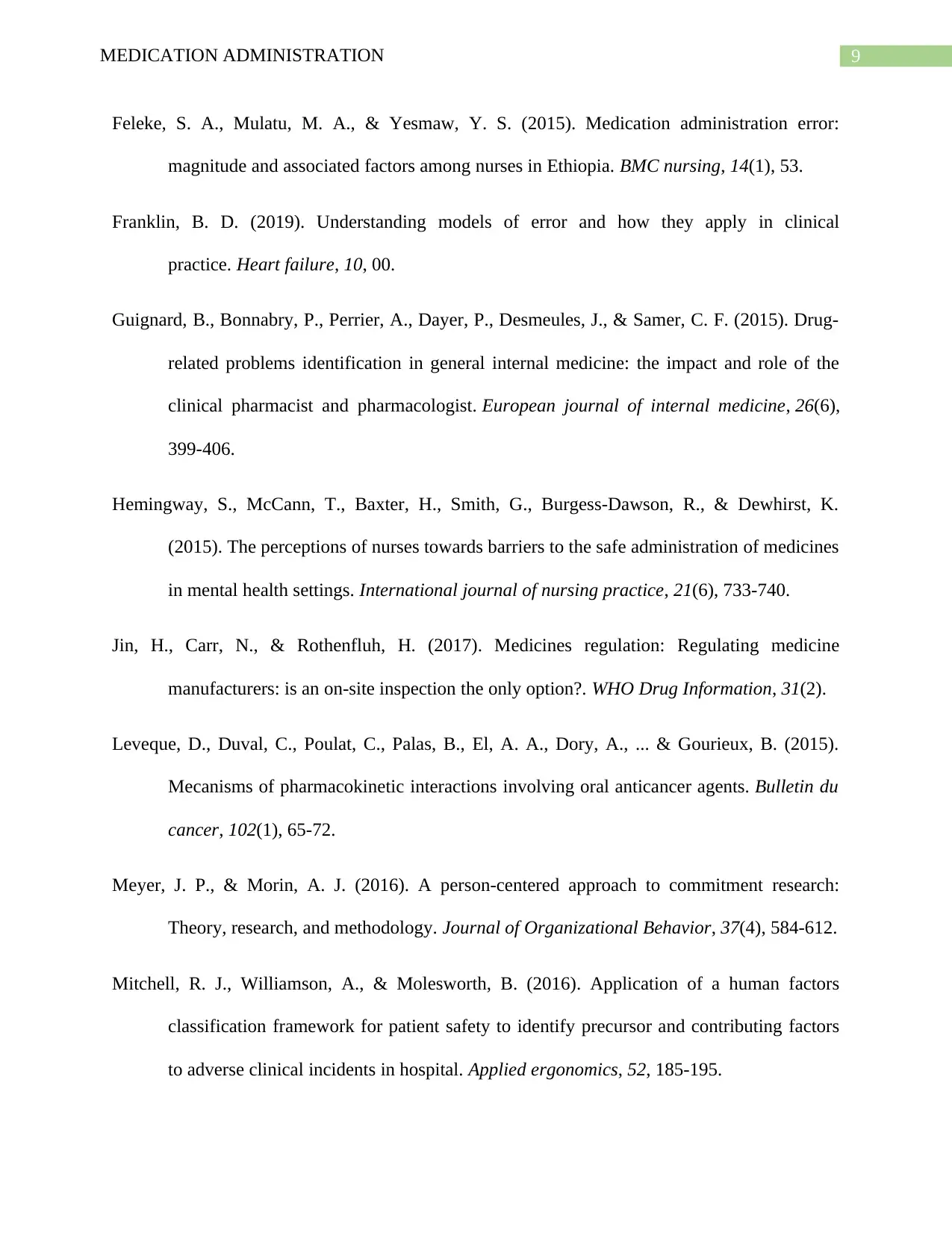
9MEDICATION ADMINISTRATION
Feleke, S. A., Mulatu, M. A., & Yesmaw, Y. S. (2015). Medication administration error:
magnitude and associated factors among nurses in Ethiopia. BMC nursing, 14(1), 53.
Franklin, B. D. (2019). Understanding models of error and how they apply in clinical
practice. Heart failure, 10, 00.
Guignard, B., Bonnabry, P., Perrier, A., Dayer, P., Desmeules, J., & Samer, C. F. (2015). Drug-
related problems identification in general internal medicine: the impact and role of the
clinical pharmacist and pharmacologist. European journal of internal medicine, 26(6),
399-406.
Hemingway, S., McCann, T., Baxter, H., Smith, G., Burgess‐Dawson, R., & Dewhirst, K.
(2015). The perceptions of nurses towards barriers to the safe administration of medicines
in mental health settings. International journal of nursing practice, 21(6), 733-740.
Jin, H., Carr, N., & Rothenfluh, H. (2017). Medicines regulation: Regulating medicine
manufacturers: is an on-site inspection the only option?. WHO Drug Information, 31(2).
Leveque, D., Duval, C., Poulat, C., Palas, B., El, A. A., Dory, A., ... & Gourieux, B. (2015).
Mecanisms of pharmacokinetic interactions involving oral anticancer agents. Bulletin du
cancer, 102(1), 65-72.
Meyer, J. P., & Morin, A. J. (2016). A person‐centered approach to commitment research:
Theory, research, and methodology. Journal of Organizational Behavior, 37(4), 584-612.
Mitchell, R. J., Williamson, A., & Molesworth, B. (2016). Application of a human factors
classification framework for patient safety to identify precursor and contributing factors
to adverse clinical incidents in hospital. Applied ergonomics, 52, 185-195.
Feleke, S. A., Mulatu, M. A., & Yesmaw, Y. S. (2015). Medication administration error:
magnitude and associated factors among nurses in Ethiopia. BMC nursing, 14(1), 53.
Franklin, B. D. (2019). Understanding models of error and how they apply in clinical
practice. Heart failure, 10, 00.
Guignard, B., Bonnabry, P., Perrier, A., Dayer, P., Desmeules, J., & Samer, C. F. (2015). Drug-
related problems identification in general internal medicine: the impact and role of the
clinical pharmacist and pharmacologist. European journal of internal medicine, 26(6),
399-406.
Hemingway, S., McCann, T., Baxter, H., Smith, G., Burgess‐Dawson, R., & Dewhirst, K.
(2015). The perceptions of nurses towards barriers to the safe administration of medicines
in mental health settings. International journal of nursing practice, 21(6), 733-740.
Jin, H., Carr, N., & Rothenfluh, H. (2017). Medicines regulation: Regulating medicine
manufacturers: is an on-site inspection the only option?. WHO Drug Information, 31(2).
Leveque, D., Duval, C., Poulat, C., Palas, B., El, A. A., Dory, A., ... & Gourieux, B. (2015).
Mecanisms of pharmacokinetic interactions involving oral anticancer agents. Bulletin du
cancer, 102(1), 65-72.
Meyer, J. P., & Morin, A. J. (2016). A person‐centered approach to commitment research:
Theory, research, and methodology. Journal of Organizational Behavior, 37(4), 584-612.
Mitchell, R. J., Williamson, A., & Molesworth, B. (2016). Application of a human factors
classification framework for patient safety to identify precursor and contributing factors
to adverse clinical incidents in hospital. Applied ergonomics, 52, 185-195.
Paraphrase This Document
Need a fresh take? Get an instant paraphrase of this document with our AI Paraphraser
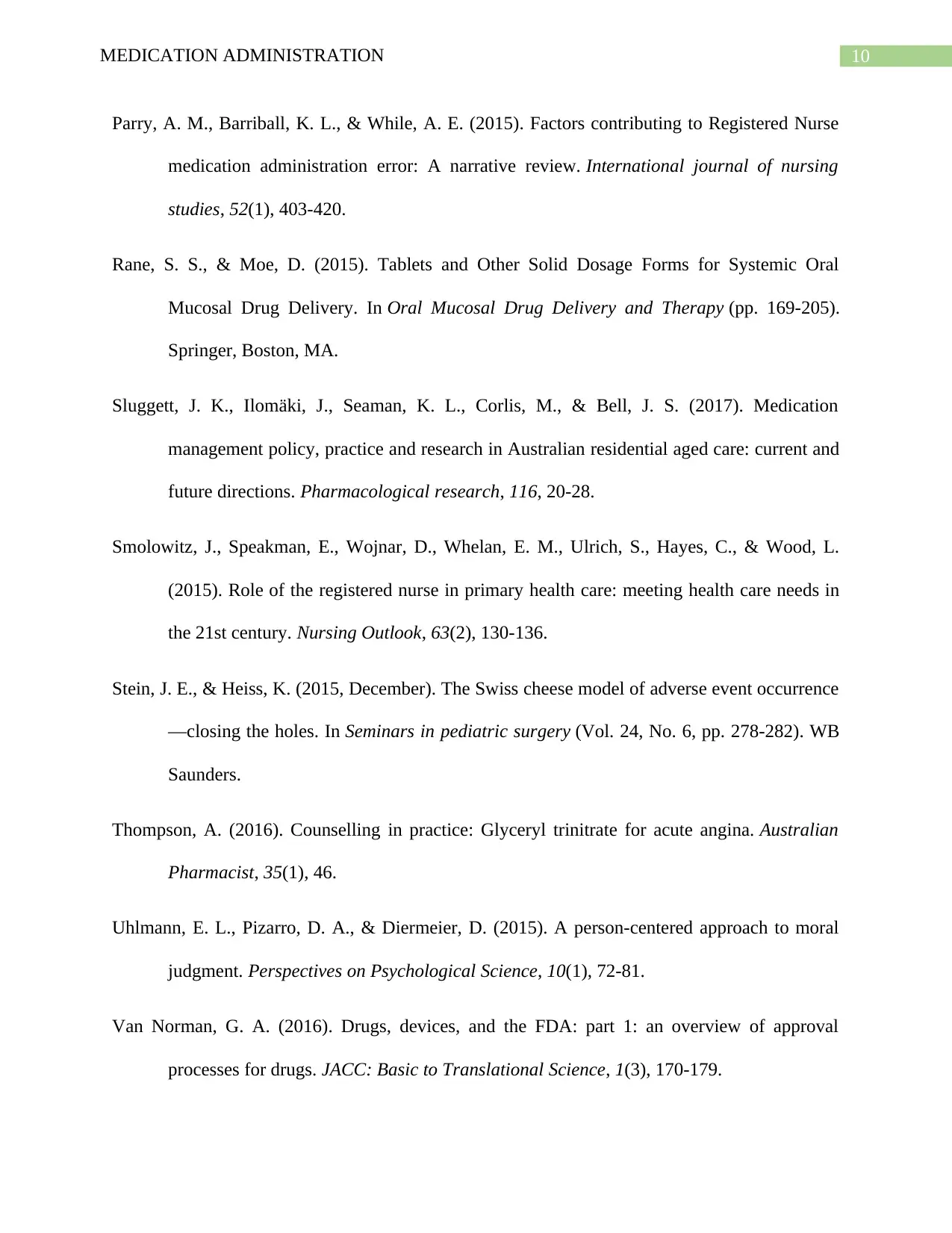
10MEDICATION ADMINISTRATION
Parry, A. M., Barriball, K. L., & While, A. E. (2015). Factors contributing to Registered Nurse
medication administration error: A narrative review. International journal of nursing
studies, 52(1), 403-420.
Rane, S. S., & Moe, D. (2015). Tablets and Other Solid Dosage Forms for Systemic Oral
Mucosal Drug Delivery. In Oral Mucosal Drug Delivery and Therapy (pp. 169-205).
Springer, Boston, MA.
Sluggett, J. K., Ilomäki, J., Seaman, K. L., Corlis, M., & Bell, J. S. (2017). Medication
management policy, practice and research in Australian residential aged care: current and
future directions. Pharmacological research, 116, 20-28.
Smolowitz, J., Speakman, E., Wojnar, D., Whelan, E. M., Ulrich, S., Hayes, C., & Wood, L.
(2015). Role of the registered nurse in primary health care: meeting health care needs in
the 21st century. Nursing Outlook, 63(2), 130-136.
Stein, J. E., & Heiss, K. (2015, December). The Swiss cheese model of adverse event occurrence
—closing the holes. In Seminars in pediatric surgery (Vol. 24, No. 6, pp. 278-282). WB
Saunders.
Thompson, A. (2016). Counselling in practice: Glyceryl trinitrate for acute angina. Australian
Pharmacist, 35(1), 46.
Uhlmann, E. L., Pizarro, D. A., & Diermeier, D. (2015). A person-centered approach to moral
judgment. Perspectives on Psychological Science, 10(1), 72-81.
Van Norman, G. A. (2016). Drugs, devices, and the FDA: part 1: an overview of approval
processes for drugs. JACC: Basic to Translational Science, 1(3), 170-179.
Parry, A. M., Barriball, K. L., & While, A. E. (2015). Factors contributing to Registered Nurse
medication administration error: A narrative review. International journal of nursing
studies, 52(1), 403-420.
Rane, S. S., & Moe, D. (2015). Tablets and Other Solid Dosage Forms for Systemic Oral
Mucosal Drug Delivery. In Oral Mucosal Drug Delivery and Therapy (pp. 169-205).
Springer, Boston, MA.
Sluggett, J. K., Ilomäki, J., Seaman, K. L., Corlis, M., & Bell, J. S. (2017). Medication
management policy, practice and research in Australian residential aged care: current and
future directions. Pharmacological research, 116, 20-28.
Smolowitz, J., Speakman, E., Wojnar, D., Whelan, E. M., Ulrich, S., Hayes, C., & Wood, L.
(2015). Role of the registered nurse in primary health care: meeting health care needs in
the 21st century. Nursing Outlook, 63(2), 130-136.
Stein, J. E., & Heiss, K. (2015, December). The Swiss cheese model of adverse event occurrence
—closing the holes. In Seminars in pediatric surgery (Vol. 24, No. 6, pp. 278-282). WB
Saunders.
Thompson, A. (2016). Counselling in practice: Glyceryl trinitrate for acute angina. Australian
Pharmacist, 35(1), 46.
Uhlmann, E. L., Pizarro, D. A., & Diermeier, D. (2015). A person-centered approach to moral
judgment. Perspectives on Psychological Science, 10(1), 72-81.
Van Norman, G. A. (2016). Drugs, devices, and the FDA: part 1: an overview of approval
processes for drugs. JACC: Basic to Translational Science, 1(3), 170-179.
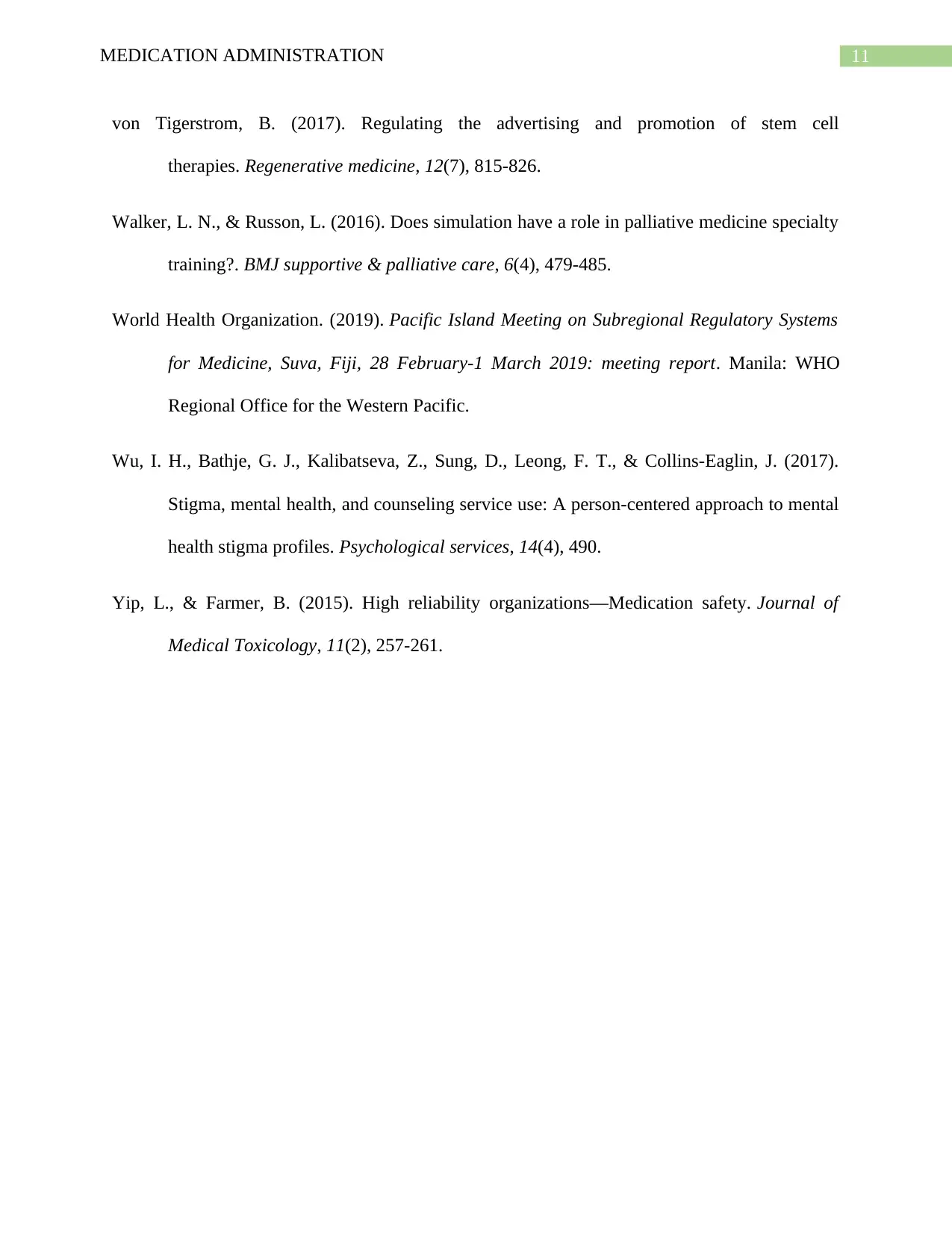
11MEDICATION ADMINISTRATION
von Tigerstrom, B. (2017). Regulating the advertising and promotion of stem cell
therapies. Regenerative medicine, 12(7), 815-826.
Walker, L. N., & Russon, L. (2016). Does simulation have a role in palliative medicine specialty
training?. BMJ supportive & palliative care, 6(4), 479-485.
World Health Organization. (2019). Pacific Island Meeting on Subregional Regulatory Systems
for Medicine, Suva, Fiji, 28 February-1 March 2019: meeting report. Manila: WHO
Regional Office for the Western Pacific.
Wu, I. H., Bathje, G. J., Kalibatseva, Z., Sung, D., Leong, F. T., & Collins-Eaglin, J. (2017).
Stigma, mental health, and counseling service use: A person-centered approach to mental
health stigma profiles. Psychological services, 14(4), 490.
Yip, L., & Farmer, B. (2015). High reliability organizations—Medication safety. Journal of
Medical Toxicology, 11(2), 257-261.
von Tigerstrom, B. (2017). Regulating the advertising and promotion of stem cell
therapies. Regenerative medicine, 12(7), 815-826.
Walker, L. N., & Russon, L. (2016). Does simulation have a role in palliative medicine specialty
training?. BMJ supportive & palliative care, 6(4), 479-485.
World Health Organization. (2019). Pacific Island Meeting on Subregional Regulatory Systems
for Medicine, Suva, Fiji, 28 February-1 March 2019: meeting report. Manila: WHO
Regional Office for the Western Pacific.
Wu, I. H., Bathje, G. J., Kalibatseva, Z., Sung, D., Leong, F. T., & Collins-Eaglin, J. (2017).
Stigma, mental health, and counseling service use: A person-centered approach to mental
health stigma profiles. Psychological services, 14(4), 490.
Yip, L., & Farmer, B. (2015). High reliability organizations—Medication safety. Journal of
Medical Toxicology, 11(2), 257-261.
⊘ This is a preview!⊘
Do you want full access?
Subscribe today to unlock all pages.

Trusted by 1+ million students worldwide
1 out of 12
Related Documents
Your All-in-One AI-Powered Toolkit for Academic Success.
+13062052269
info@desklib.com
Available 24*7 on WhatsApp / Email
![[object Object]](/_next/static/media/star-bottom.7253800d.svg)
Unlock your academic potential
Copyright © 2020–2025 A2Z Services. All Rights Reserved. Developed and managed by ZUCOL.





